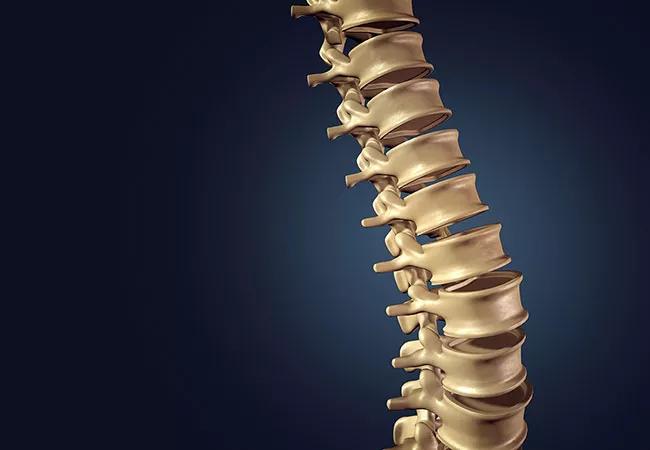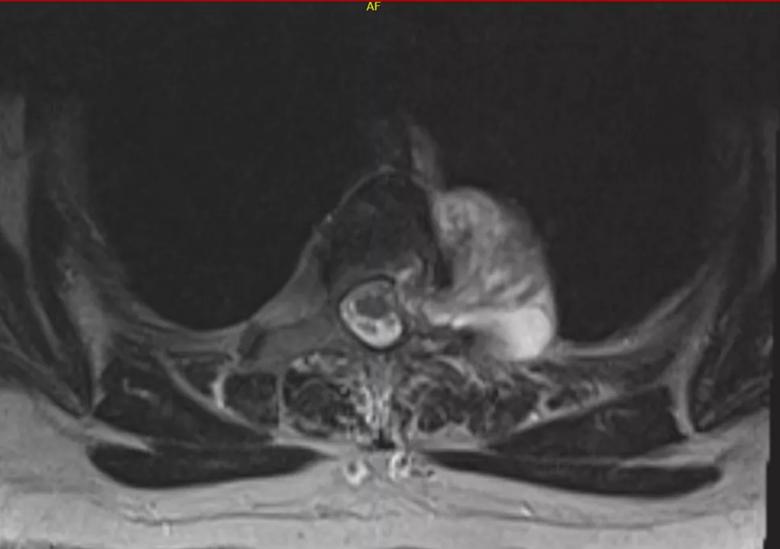Two-day procedure prevents neurologic compromise for octogenarian

An 82-year-old woman presented to Cleveland Clinic with right shoulder pain. An MRI of the spine revealed an incidental left paravertebral mass measuring 4.2 cm in maximal direction. There was extension into the T3 intervertebral foramen with remodeling of the adjacent vertebrae.
Advertisement
Cleveland Clinic is a non-profit academic medical center. Advertising on our site helps support our mission. We do not endorse non-Cleveland Clinic products or services. Policy
“Because of the relative lack of symptoms on the left and the patient’s concern about having a major surgery at her age, she consulted with the spine team and decided on observation,” says Daniel Raymond, MD, a thoracic surgeon in the Miller Family Heart, Vascular & Thoracic Institute at Cleveland Clinic.

A mass can be seen pushing the patient’s spinal cord to the right. The tumor extends through the neuroforamen from the outside and into the spinal canal.
During the surveillance period, the patient began to develop pain over her left scapula. She underwent physical therapy, but the pain continued intermittently. Seventeen months after her initial MRI, repeat imaging showed significant extension of the schwannoma into the spinal canal, with compression of the thecal sac and contact with the spinal cord.
“Typically, you wouldn’t expect to see a dramatic change in a schwannoma in only a year or so,” says Dr. Raymond. “In this case, the tumor was pushing on the patient’s spine, causing symptoms and growing relatively quickly.” He and Richard Schlenk, MD, a neurosurgeon and Neurosurgery Residency Training Program Director at Cleveland Clinic, decided that a hybrid resection of the dumbbell-shaped schwannoma was the best course of action.
Dr. Schlenk performed a T2-3 laminectomy using a standard posterior approach to the spinal component of the paravertebral mass. The following day, Dr. Raymond performed robotic thoracic surgery on the remaining intrathoracic component, encircling and removing the mass located on top of the aorta.
Advertisement
The surgeons opted for a two-day procedure due to the patient’s age and her concerns about the recovery process.
“The stress on the system can be a lot for an octogenarian, so we do the spine surgery first and allow the patient to recover overnight,” explains Dr. Raymond. “This approach gives us an opportunity to medically optimize our patients before putting them through a second significant operation.”
The patient in this case had an uncomplicated postoperative course and was discharged home on day four. Pathology results confirmed a grade 1 spinal schwannoma. Her long-term prognosis is excellent.
Dr. Raymond credits the success of the surgery to collaboration among the multidisciplinary team. “We have a great system. It’s not about the individual surgeon: It’s the team and culture,” he says.
Working in tandem, clinicians from thoracic surgery and neurosurgery charted a course to treat the patient based on her physiological status, not her chronological age.
“So often, we see people in our clinic who have been told they are too old for surgery,” says Dr. Raymond. “A person like this patient is clearly a candidate for surgery. We gave her an excellent operation and prevented her from serious neurologic compromise. She did great.”
Advertisement
Advertisement

Large retrospective study suggests DOACs are safe, effective alternative to low-molecular-weight heparin in complex patient population

Care paths and research initiatives aim to answer unmet clinical needs

Study shows high rate of hematologic responses, low rate of disease progression

Bispecific antibody bridging therapy deepens durability of BCMA CAR T-cell therapy without overlapping toxicities in patients with relapsed/refractory multiple myeloma

Phase 2 study brings pivotal advances in treatment efficacy and safety for the most challenging-to-treat population

Patient with quadruple refractory multiple myeloma achieves complete response with cell therapy

Distinct baseline immune profiles can predict response and resistance to different types of CAR-T cells.

National Blood Clot Alliance collaborates with faith-based organizations on first-of-its-kind church bus tour